Today I'm going to be reviewing the NRS Kuda 126 Inflatable Fishing Kayak.
The Kuda 126 is an inflatable sit-on-top kayak, but it’s very similar to what I’d consider a stand-up paddleboard. It has a wide, flat surface and a framed seat with similar technology to what’s found on other NRS rafts.
The Kuda 126 is a very durable inflatable kayak. This is important because people who see me fishing from inflatables always ask if I’m worried about punctures caused by fish hooks and other sharp objects. The answer is no. People have been fishing from inflatable rafts and kayaks for a long time, and it’s never been a problem for me. I actually think you’d have to try pretty hard to put a hook through the Kuda’s tough skin.
Now let’s take a closer look at different options, what I like and dislike about the Kuda 126, and where I see it making the most sense in this NRS Kuda Kayak Review.
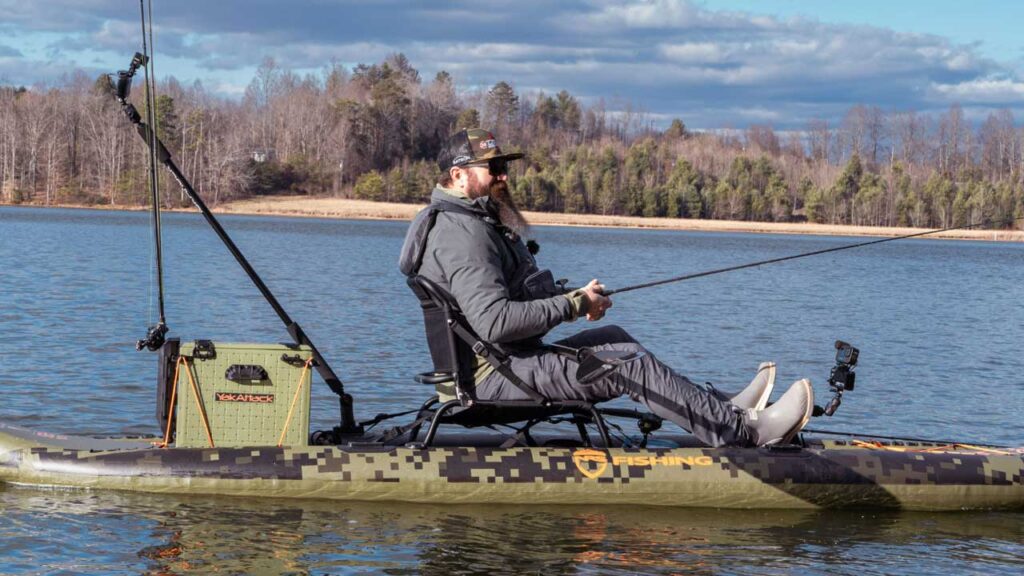
Kuda Fishing Kayaks Come in Two Sizes
I really like that Kudas are available in two sizes. You can choose between the 10-foot 8-inch version called the 106, or the 12-foot 6-inch model called the 126. Both boats are 38 inches wide and very light. The 106 weighs just 27 pounds, while the 126 comes in at 31 pounds.
The Kuda we tested had a 300-pound capacity according to NRS’ website. I actually think that’s pretty conservative because I weigh about 220 pounds. Even with me and 30 or 40 pounds of gear, the Kuda 126 felt rock-solid and stable.
So I’d have no concerns with safety or stability even if I was going to add extra gear for an overnight camping trip.
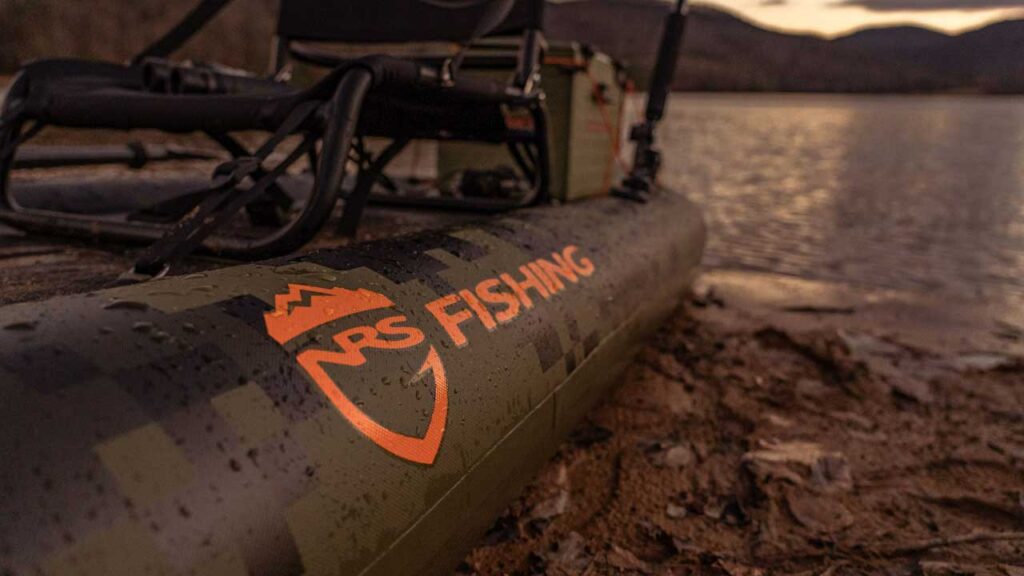
NRS Kuda – Standard Equipment and Construction
Both the 106 and the 126 come with a backpack, a patch kit, a fin, a framed seat, and a manual pump to inflate the boat.
This particular inflatable fishing kayak has two chambers on the outside that inflate to around 3 PSI. There’s another drop-stitched chamber in the floor that can be inflated up to about 8 PSI. It says on the board that the floor can be inflated up to 20 PSI. However, I recommend sticking to 8 or 9 PSI. Even at those numbers, it’s very rigid even when you’re standing up. I had no problem moving around the boat. It actually felt just as stable as most solid plastic kayaks.
It also helps that the chambers are glued. And since Kudas have three three air chambers, you’ll definitely stay afloat and be able to get to shore if one gets punctured or springs a leak.
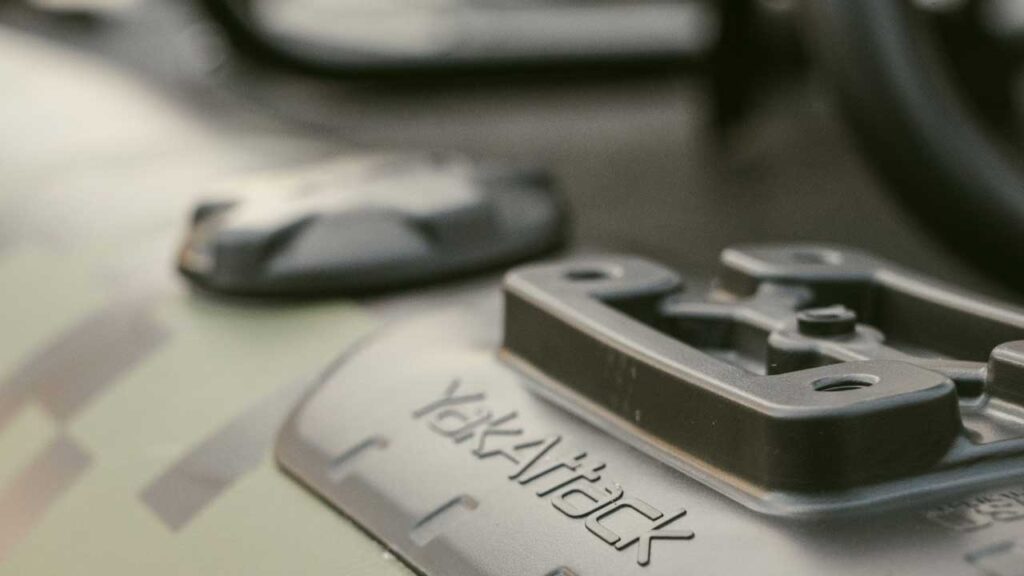
This is why I always recommend carrying that patch kit and a small hand pump with you. The pump that comes with the Kuda works well, but I strongly recommend picking up an electric pump. A good electric pump will save you tons of time and energy, especially if you’ll be using the boat a lot and deflating it when it’s being stored.
Play it Safe – Don’t Overinflate Your Kayak
I love inflatable fishing crafts because they’re versatile and lots of fun. That said, you do need to be careful when filling them with air. This is especially true if you’ll be using your inflatable on a day when it’s cool in the morning but warms up later on.
This warming and even direct exposure to sunlight on relatively cool days can cause the air inside the boat to expand. If you’ve pumped the chambers up to max PSI or beyond, the expansion could cause problems like a split seam or a ruptured tube.
Just keep temperature changes and sunlight in mind when you’re using and storing the boat and you’ll be fine.
Kudas are Reasonably Priced
The MSRP for the Kuda 106 is $1,395, while 126s like the one we tested cost $1,495.
Now when it comes to inflatable kayaks, you may think they’re slightly less expensive and somewhat low-end options comparable to hard shell kayaks in the $1,600 to $1,800 range. But that’s not necessarily the case. What you get with the Kuda, and with NRS’ sit-inside version called the Pike, is lots of value and durability, as well as years of knowledge that went into design and construction.
NRS has been making fishing rafts for a very long time, so they definitely know what they’re doing.
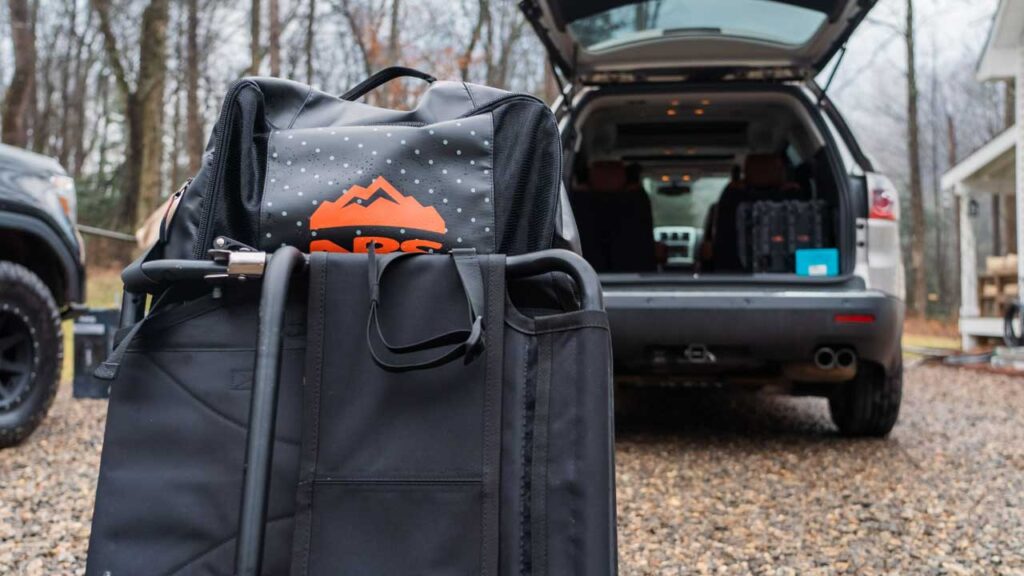
Kuda 126 – Easy to Transport, Pack, and Store
As I said, the Kuda 126 is a versatile boat that gives you a lot of value.
There are lots of options out there, but the Kuda 126 is definitely worth considering if you have limited storage space and don’t have a truck or trailer to haul a bigger boat. It's also easy to inflate and folds up and fits inside the backpack that comes with the boat. This allows you to transport it in the trunk or back seat of a car and store it in a closet at home.
And best of all, you get all this convenience without having to sacrifice a ton of performance.
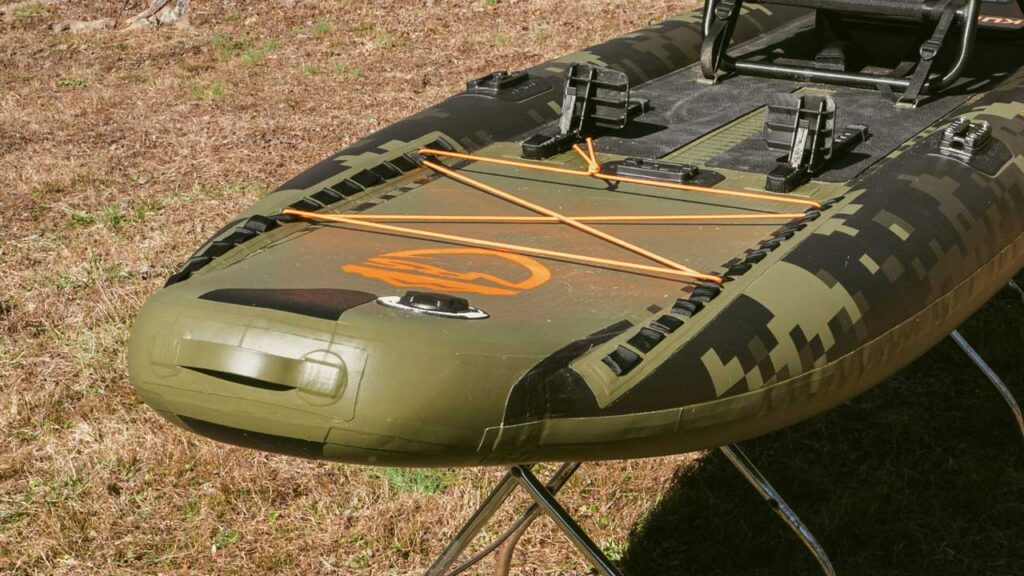
Features – the Front of the Boat
Let's start at the bow.
The Kuda 126 comes with a sturdy handle that makes getting it to and from the water a piece of cake. It also comes with a bungee and a number of D-rings down both sides that make it easy to stow gear.
You also get a reinforced area in the bow that provides added protection. This will come in handy if you plan on running an anchor line up front. One thing you’ll notice is that the Kuda 126 has a number of areas with extra material for added durability. For example, there’s an EVA foam pad over the standing area and extra material on skid areas on both the bow and stern where the boat will experience the most friction.
Protection like this will allow the boat to take abuse and last longer. From that standpoint, I really think the boat was thought out really well.
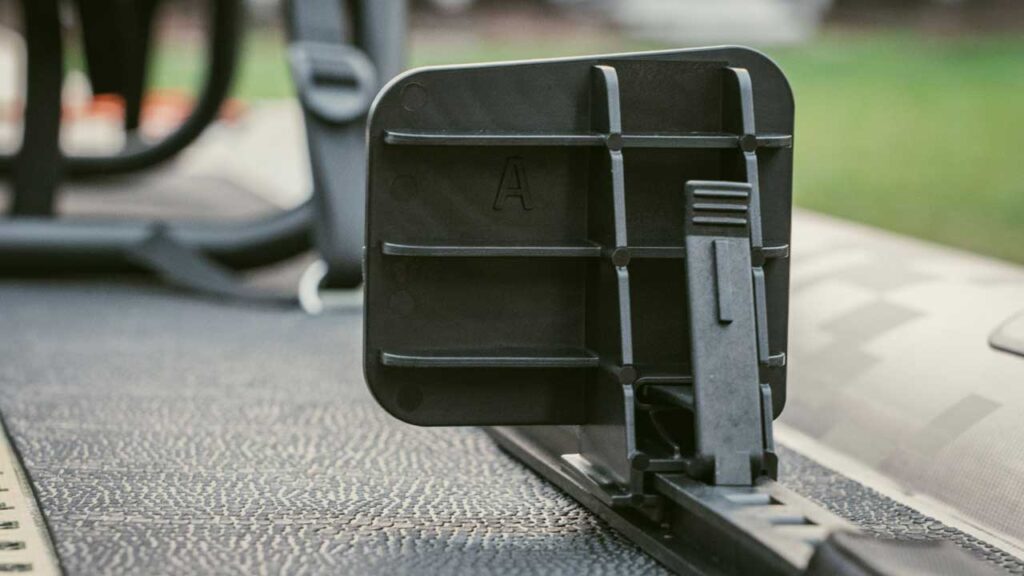
Kuda 126 – Foot Pegs Included
I'm also very happy that the Kuda comes with foot pegs.
Many of the inflatable boats I’ve used in the past didn’t have foot pegs. This is a big deal for me because I like to engage my core when I’m paddling. Without foot pegs, bracing yourself and engaging your core is nearly impossible. But with foot pegs, you can use your legs and core too instead of relying on your arms and shoulders. This means you’ll be able to spend more quality time on the water without getting worn out. In addition, it generally means less aches, pains, and soreness the following day.
The Kuda’s foot pegs are also adjustable, so you’ll be able to get the seating area dialed in regardless of how long or short your legs are.
I feel like NRS put the pegs on the boat in the best possible way. Even with the foot pegs, it’s easy to deflate the boat and pack it down. All you have to do is slide them out before packing the boat into the backpack.
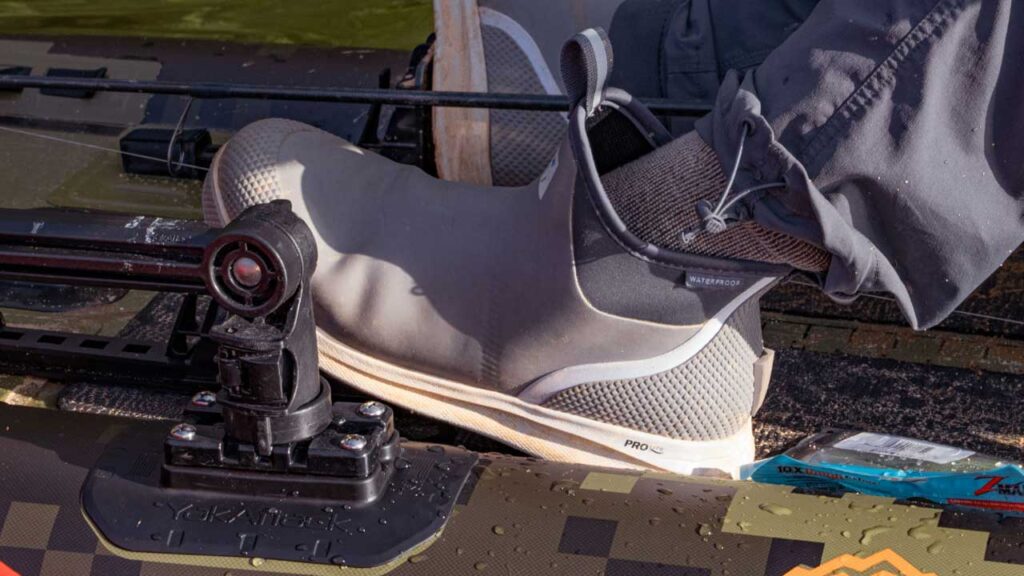
Plenty of Accessory Mounting Options
Another thing I love about the Kuda is how easy it is to mount accessories around the boat.
This is especially cool because NRS used YakAttack’s new Switch Pad. This allows you to add the YakAttack Switch, which is a short piece of gear track that gives you the ability to mount different accessories with ease.
You can also glue more Switch Pads onto the boat wherever you need them, but it comes with five right out of the gate. Just keep in mind that you’ll have to buy the Switches from YakAttack.
I do wish the Kuda came with five Switches to go with the five Switch Pads, but it’s easy to pick those up from YakAttack. However, it was another step I had to take to get the boat rigged the way I wanted it.

Solid, Slip-Resistant Standing Area
NRS put a lot of thought into the floor and standing area on the Kuda 126.
The boat comes with an EVA pad over the floor which definitely gave me confidence when it came to dropping hooks and sharp tools that could potentially cause wear or punctures. Again, this type of damage to an inflatable has never happened to me, but it’s not out of the question.
In addition to extra thickness and protection, the EVA pad provides extra grip when the boat gets wet. PVC-style material can get pretty slick when it’s wet, so this provides some reassuring grip in that standing area down the center of the boat.
It may seem like a small thing, but the Kuda 126 comes with a 24-inch measuring board between the foot pegs. This handy feature allows you to cull fish quickly in a tournament situation without having to pull out another board stowed on the boat.
I also appreciated the measuring board because I like to know when I get in that trophy range when I'm catching different fish.
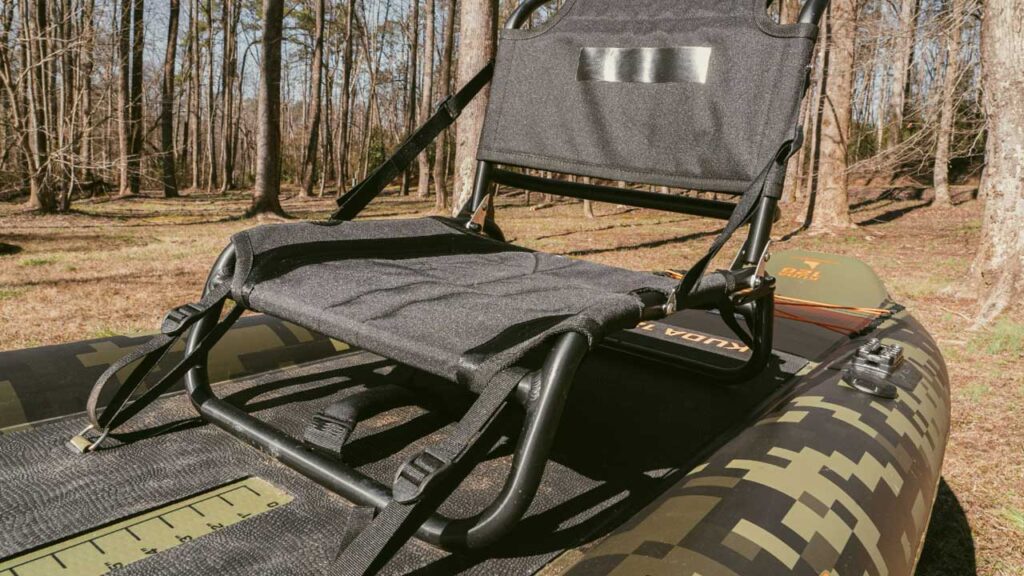
Adjustable, Lightweight Seat
The Kuda’s seat is relatively flat and doesn’t have a lot of lumbar support, but I found it to be pretty comfortable. It’s lightweight and easy to pack down. Another plus is that it’s simple to attach the seat to the deck using the straps and D-rings.
You can also adjust it slightly forward and aft. This is a great feature because it allows you to dial the boat in just the way you want it. This will make you more comfortable and efficient out on the water, and it’ll help with speed and tracking too.
On the downside, getting up and down can be tricky since the seat is a little bit lower than some of the high-low seating options on hard-shell kayaks. In fact, you may want to consider adding some type of strap to help you get up and down. If you do, you could probably rig it to one of the YakAttack Switch Pads. A strap would be a big help when you’re sitting down because you wouldn’t have to fall back into the seat. But other than that, getting up and down is pretty easy and the boat always felt very solid and stable.
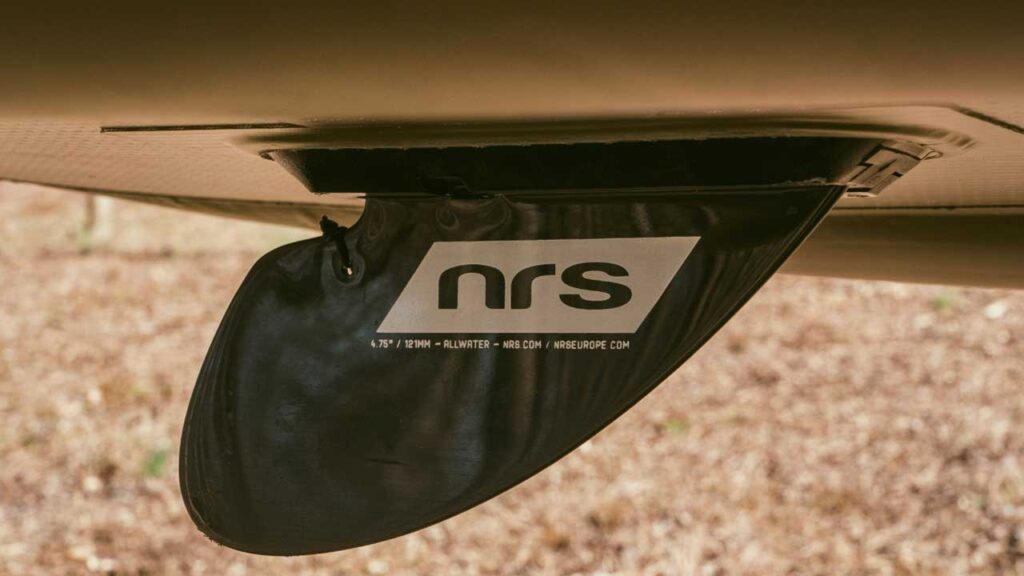
Kudas Come with Detachable Fins
Both Kudas come with NRS’ all-water fin.
This relatively low-profile fin sticks down about four or five inches below the boat. The all-water fin works well if you’ll be paddling and fishing in lakes and ponds with more open water. This fin will allow the boat to track really well in situations like these.
However, I picked up one of NRS’s whitewater fins because I tend to use the Kuda more in moving water. The difference between the two is that the whitewater fin is shorter than the all-water fin. But I found that the whitewater fin still helps keep the boat tracking straight.
Either way, both fins work well because inflatable craft have a tendency to be blown or moved around by wind and currents since they ride pretty high in the water. So again, the all-water fin is best for open water, while the whitewater fin works best in shallow and moving water situations.
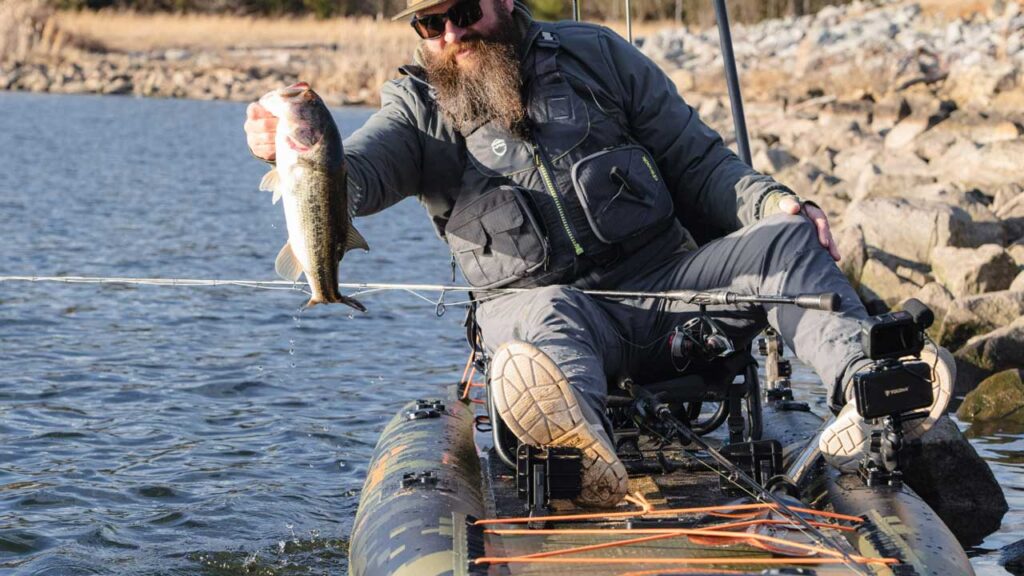
Who Should Consider NRS’ Kuda 126
The NRS Kuda 126 definitely gets high marks for durability, versatility, and ease of use. In general, it's tough, stable, and easy to set up and transport.
I think it’s a great fit for anyone who stays out on the water in small stretches and doesn’t have a pick-up truck or trailer to haul a bigger boat. It’s also a great option if storage space is an issue because it packs down into a convenient backpack that doesn’t take up much space.
The Kuda is easy to get to and from the water, and you can rig it out with all the accessories you need to catch fish. You’ll appreciate how nimble it is, and how easy it is to maneuver and paddle in open water.
I’d definitely recommend investing in an electric pump. However, this is one of those boats that you’ll be able to have a lot of fun with right out of the box. All you really need is a paddle, a PFD, and your fishing gear and you’re good to go.
So that’s my review of the Kuda 126!
I really like this boat. I plan on taking it river fishing a lot this year, and in many respects I think it’s the perfect boat for that type of water.
Check out my NRS Pike Pro 126 Inflatable Fishing Kayak Review as well.
Follow my Adventures and Subscribe
If you enjoyed this article and are hungry for more adventure fishing tips, tricks, reviews, and adventures? Head on over to the Road Trip Angler YouTube channel and feel free to sign up for our In4Adventure.com newsletter.

Inflatable fishing kayak: NRS Kuda 126 Inflatable Fishing Kayak
Life vest: NRS Chinook PFD
Accessories: YakAttack Omega Rod Holder, and the YakAttack BlackPak Pro
Shirt: NRS Varial Hoodie
Footwear: Xtratuf Men's Ankle Deck Boots
Rods: Judge Crankbait Series, Eternity Series, Revelation Series
Sunglasses: Wiley X



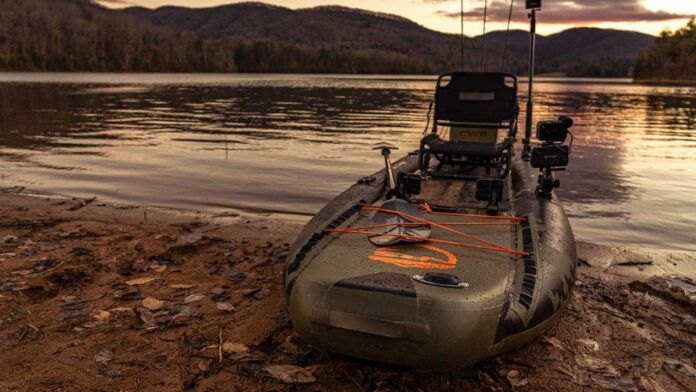
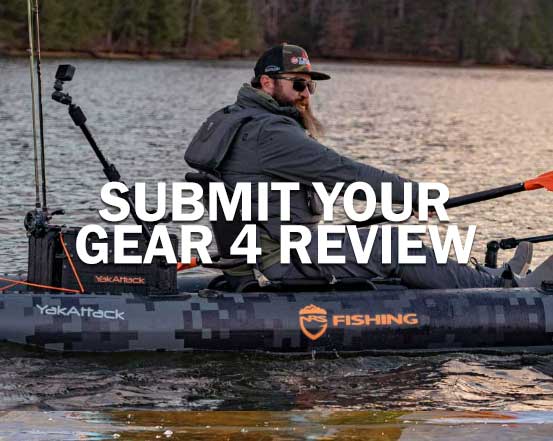









Completely agree. I have the NRS 126 KUDA and I love it. Spread the word, I got mine because I got tired of going on RV trips to great lake, river and bays and not be able to explore those beautiful bodies of water. I’ll pass on the electric air pump. The pump that comes with it is excellent, 125 pumps for the center and 25-30 for each pontoon tube. Easy, quick and QUIET. Working on adding a trolling motor soon.